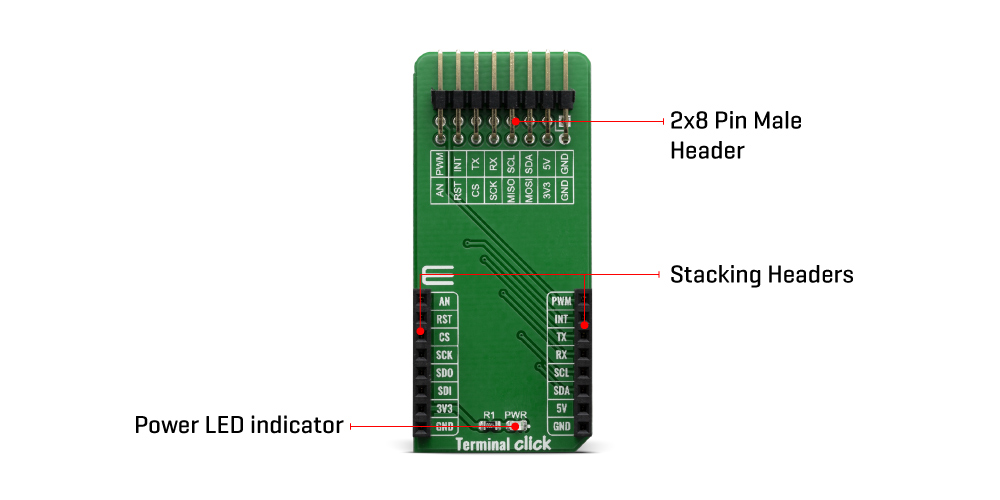- Order number: MIKROE-3745
- Manufacturer product ID: 3745
Terminal click is a mikroBUS™ socket expansion board, which provides an easy and elegant solution for adding the external connection capability to the click board™, plugged on a mikroBUS™. Featuring stacking headers makes it easy way for expanding the connectivity of the development system with the mikroBUS™, while keeping the bus free to use with any click board™.
Terminal click is supported by a mikroSDK compliant library, which includes functions that simplify software development. This Click board™ comes as a fully tested product, ready to be used on a system equipped with the mikroBUS™ socket.
Terminal click can be especially interesting for the development systems that are equipped with mikroBUS™ slots only, or small number of GPIO pins available, such as the Clicker family of development systems. Using Terminal click on such system will greatly improve its usability, and yet it will remain small, compact and manageable. Thanks to standard-pitch (2.54mm) header, it is easy to connect a wire jumper, a probe of an oscilloscope for example, or maybe some additional electronic circuit. That way, Terminal click makes it easy monitor signals in real-time, while the click board is present in the system.
HOW DOES IT WORK?
Terminal click consists of a high-quality PCB that can be connected to the mikroBUS™ as any other click board. On the top of the Terminal click, a 2x8 pin header is placed. Each of the header pins is corresponding to a pin on the mikroBUS™ being used. These are simply wired in parallel. Thanks to the stacking headers, the connection with the click board™ remains firm and stable. Besides . Having this kind of stacking topology, allows for easy pin access and manipulation of the stacked click boards™, retaining a perfect connection quality at all times.

When there's a need to attach external equipment to the development system, the desired mikroBUS™ socket can be populated with Terminal click, allowing even more connections. This makes the stacking capacity almost unlimited. However, attention should be paid not to make the lines attached to the mikroBUS™ too long. In situations like this, the frequency of the communication might need to be stepped down a bit, in order to compensate for the longer mikroBUS™ signal lines.
Lines of the mikroBUS™ to which Terminal click is attached, are shared through the top 16-pin header, which mirrors pins of the connected mikroBUS™. Therefore, a care should be taken when working with the Terminal click and connecting an external device to it, because the same pins on the mikroBUS™ are shared, either for the communication (SPI, UART, I2C) or for some other purpose (RST, INT, or other pins used as GPIO).
Since all the stacked click boards™ share the same power rails, a Terminal click also shares the power rails, which makes it compatible with any click board™ and development systems.
CLICK BOARD™ PRODUCT RANGE
The union of Terminal click with the other click boards™ allows you to reach an unlimited number of possibilities when it comes to combining different functionalities and adding external connectivity. You just need to choose the ones you want from our ever-growing range: environmental sensors, LEDs, speech recognition, heart rate sensors, motor control, GSM, GPS, WiFi, analog to digital converters, movement sensors.
More than 700 click boards™ that can be stacked and integrated in a simple and convenient way are at your disposal.
SPECIFICATIONS
| Type | Adapter |
| Applications | Provides easy, secure and reliable stacking of up to four additional boards per mikroBUS™ socket. |
| Interface | GPIO |
| Click board size | L (57.15 x 25.4 mm) |
| Input Voltage | 3.3V,5V |
PINOUT DIAGRAM
This table shows how the pinout on Terminal Click corresponds to the pinout on the mikroBUS™ socket (the latter shown in the two middle columns).
ONBOARD SETTINGS AND INDICATORS
| Label | Name | Default | Description |
|---|---|---|---|
| LD1 | PWR | - | Power LED Indicator |
| J1 | HM2X8 | - | J1 Connector (2.54mm pitch, male header) has 16 pins, one for every mikroBUS™ pin. |








